
Hop on the LGU P4 DILG bandwagon
Hop on the LGU P4 DILG bandwagon
 WHAT is this P4 Program for local govern-ment units(LGUs)? What is the difference between P4 and P3, or public-private partnership? What is the role of the Depart-ment of the Interior and Local Government (DILG) in the promotion of P3/P4 at the local government level?
WHAT is this P4 Program for local govern-ment units(LGUs)? What is the difference between P4 and P3, or public-private partnership? What is the role of the Depart-ment of the Interior and Local Government (DILG) in the promotion of P3/P4 at the local government level?
DILG memorandum circular (MC) issued. Last Tuesday, September 6, Secretary Ismael D. Sueño signed an MC setting into motion the department’s LGU P4 initiative. P4 stands for PPP for the People. The Union of Local Authorities of the Philippines, private-sector umbrella organizations, PPP Center and the DILG family witnessed the issuance of this landmark regulation.
Clear message telegraphed. The messages are clear. The DILG wants to shift the focus of PPPs, from being pure transactions and project-based to being transformational and focused on the public good. PPPs must be advanced to serve the people, hence, the fourth P. And the “people” should not be confined to people in Metro Manila, urban centers and Luzon. Secretary Sueño underscored the need to have more projects in Mindanao and the Visayas.

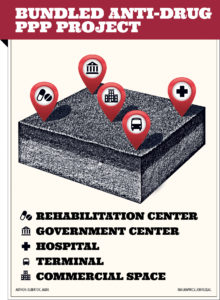 CAN there be a link between combatting the drug crisis and pursuing development through public-private partnerships (PPPs)? What antidrug programs and projects can be undertaken through PPPs? Who will be the payors of these projects? What PPP modalities can be used?
CAN there be a link between combatting the drug crisis and pursuing development through public-private partnerships (PPPs)? What antidrug programs and projects can be undertaken through PPPs? Who will be the payors of these projects? What PPP modalities can be used?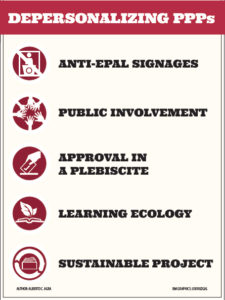 HAVE you seen government and Public-Private Partnership (PPP) projects that bear the name of the highest government official who signed the contract? What is your impression or reaction to this? If you were the successor chief executive, would you be tempted to discontinue this project or drop the name of the predecessor?
HAVE you seen government and Public-Private Partnership (PPP) projects that bear the name of the highest government official who signed the contract? What is your impression or reaction to this? If you were the successor chief executive, would you be tempted to discontinue this project or drop the name of the predecessor?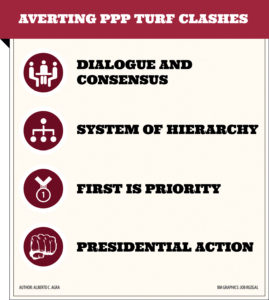 CAN a public-private partnership (PPP) project be undertaken by more than one implementing agency (IA)? How should turf issues be addressed and resolved? Which IA takes precedence? Who should undertake monorail, water, reclamation and bridge PPP projects?
CAN a public-private partnership (PPP) project be undertaken by more than one implementing agency (IA)? How should turf issues be addressed and resolved? Which IA takes precedence? Who should undertake monorail, water, reclamation and bridge PPP projects?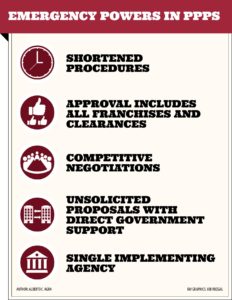 WHO will public-private partnerships (PPPs) fit into the proposed grant of emergency powers in addressing the traffic crisis? What are the boundaries of the grant of emergency powers to the Executive branch of government? What PPP related laws must be changed to expedite PPPs?
WHO will public-private partnerships (PPPs) fit into the proposed grant of emergency powers in addressing the traffic crisis? What are the boundaries of the grant of emergency powers to the Executive branch of government? What PPP related laws must be changed to expedite PPPs?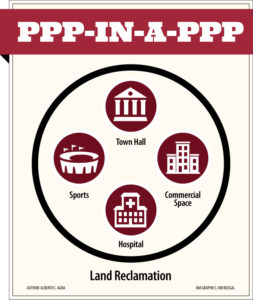 CAN a public-private partnership (PPP) project accommodate another PPP arrangement? What are the types of projects that allow this PPP-in-a-PPP approach? If this was the case, must the second PPP project go through another round of competitive process? Must the two PPP projects be pursued under the same modality? Can a completed government project permit a PPP project in the future?
CAN a public-private partnership (PPP) project accommodate another PPP arrangement? What are the types of projects that allow this PPP-in-a-PPP approach? If this was the case, must the second PPP project go through another round of competitive process? Must the two PPP projects be pursued under the same modality? Can a completed government project permit a PPP project in the future?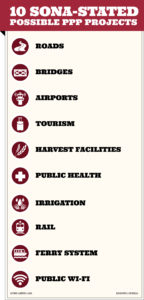 DID President Duterte mention public-private partnerships (PPPs) in his State of the Nation Address (Sona)? Can the programs and projects he enumerated last week be pursued through PPPs? Is PPP a viable option for the priority activities of the current administration?
DID President Duterte mention public-private partnerships (PPPs) in his State of the Nation Address (Sona)? Can the programs and projects he enumerated last week be pursued through PPPs? Is PPP a viable option for the priority activities of the current administration?